|
Support this site

|
The Thunder Child: Critical Mass
Rocket to the Morgue
Anthony Boucher
1942, et al, to 1988
approx 173 pages
For life in San Francisco, USA, 1942, see our
Time Travelers's Guide
|

Searching! Searching! Searching! |
Search results open in new window
|
|
|
| Rocket to the Morgue, (1942) by Anthony Boucher, is a mystery novel that features as its milieu the 1940s American science fiction writer and his world.
Science fiction as a specific genre (and in particular a specific American genre) was a little less than 20 years old. Hugo Gernsback had published the first magazine devoted only to science fiction, Amazing Stories, in 1926.
It was not until the 1940s that science fiction really took off, and enjoyed its Golden Age, with the likes of Robert Heinlein and Isaac Asimov and others - although these writers were certainly launched on the backs of 1930s authors such as E. E. Smith and Stanley Weinbaum.
|
|
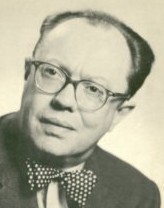
William Anthony Parker White, aka H. H. Holmes, aka Anthony Boucher |
It is this milieu that Anthony Boucher honors in Rocket to the Morgue. This would be the second to last novel Boucher wrote before giving up the book form to concentrate on short story writing (of fantasy and sf), radio scripts, book reviews, and editing the magazine he would co-found in 1949: The Magazine of Fantasy and Science Fiction.
Boucher uses the detecting pair from an earlier novel, Nine Times Nine, Sister Ursula of the convent of the Sisters of Martha of Bethany, and police detective Terry Marshall. Sister Ursula is the daughter of a police officer and had intended to become a policewoman herself before deciding to take her vows instead. |
| Rocket to the Morgue is your classic locked room problem...not once but twice.
Author Fowler Foulkes and his creation Dr. Derringer hold the same position in science fiction as Conan Doyle's Sherlock Holmes has for the mystery - the character has transcended the genre and is known around the world. Foulkes has been dead for ten years (of natural causes), and his son Hilary is the executor of his literary estate, which is worth a fortune.
Hilary takes his position very seriously, and because of his intention to get every possible bit of income out of the estate, he has made quite a few enemies. |
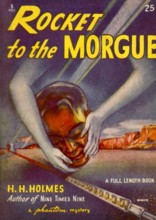
Note Holmes pseudonym |
His niece, Jenny Green, who lives in the house and works as his private secretary, is devoted to him, but others aren't so happy. His wife Veronica yearns for a more exciting life, his brother-in-law Vance Wimpole (a science fiction writer, who is engaged to Jenny) needs money to pay off blackmailers, and science fiction authors Matt Duncan and Joe Henderson have each had run-ins with the man that have cost them dearly.
Hilary himself feels that his life is in danger, as he's survived a couple of accidents, and so he calls the police for help. Detective Inspector Terence Marshall, who has called upon him while investigating the death of a bum in a flop house, coincidentally arrives at just the right time as a box of chocolates is delivered...only the box is ticking.
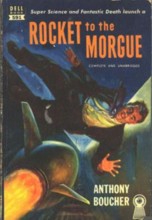
No more pseudonym |
A few of the characters in this novel are based on science fiction authors of the day.
Vance Wimpole - L. Ron Hubbard
Matt Duncan - Cleve Cartmill and Henry Kuttner
Austin Carter - Robert Heinlein
Bernice Carter - C. L. Moore and Leslyn Heinlein (?)
Joe Henderson - Jack Williamson and Edmond Hamilton
Hugo Chantrelle - Jack Parsons
(Brief bios of the authors are listed at the bottom of this article.)
|
The science fiction world during the early 1940s was a small one - everybody knew everybody else - the fans knew each other, either in person or through the mail, fans became writers, and writers became editors.
Boucher's setting is a somewhat intime one, in that we see only the inner workings of only five writers, but he is able to get across the flavor of what it was like to be a science fiction writer at the beginning of the Golden Age of Science Fiction.
Through his character of Austin Carter (based on Robert Heinlein), Boucher explains to the mystery reader of the day - who may or may not have been familiar with the relatively new form - just what science fiction is:
|
Science fiction is essentially a magazine field. Outside of Fowler Foukes and H.G. Wells, practically no contemporary imaginative writer has been commercially successful in book form. So its development has to be studied in the mags. And these, way back in the early days, were possibly, to the non-fan outsider, not so good. They had, to be sure, scope and imagination, an originality and a vigor that few other pulps could equal; and neither quality had ever been prized in the slick field.
But they also had a sort of cold inhumanity. The science was the thing, and the hell with the people involved. On the one hand you had what I call the interplanetary horse operas, which were sometimes pretty weak even on their science. These were pure Westerns translated into cosmic terms. Instead of fighting off bands of hostile red-skins, you fought off bands of hostile Martians, and as you pulled out your trusty blaster, they regularly bit the stardust.
The gadget stories were more interesting. They frequently made honest attempts at forecasting scientific developments. Atomic power, stratosphere exploration, [rocket flight], all the features that may revolutionize the second half of this century as thoroughly as radio and the airplane have transformed this half - all these became familiar, workable things.
But the writers stopped there. Interest lay in the gadget itself. And science fiction was headed for a blind alley until the realization came that even science fiction must remain fiction, and fiction is basically about people, not subatomic blasters nor time warps.
So there's a new school now, and I suppose Don Stuart, the editor of Surprising, is as responsible as anybody. Don?s ideas was this, and it was revolutionary: Grant your gadgets, and start your story from there.
In other words, assume certain advances in civilization, then work out convincingly just how those would effect the lives of ordinary individuals like you ad me.
In other words, to sum it all up in a phrase of Don's: "I want a story that could be published in a magazine of the 25th century.?
|
| Boucher references the character of Don Stuart frequently. It is the pseudonym in real life of John W. Campbell (author of Who Goes There?), who gave up writing to focus on his editing of Astounding Stories and Unknown, and the character in the book is clearly John W. Campbell, as well.
The writing
Throughout Rocket, we are treated to excerpts from a pulp adventure featuring Captain Comet, Adam Fink the androgynous robot, Gah-Djet the mechanical brain, Princess Zurilla of Neptune, and Xix, the xurghil-smuggler, as written by Joe Henderson.
These excerpts are rather a send-up of the lowest common denominator of the pulp adventure, similar to the adventure pulps of The Shadow and Doc Savage.
|
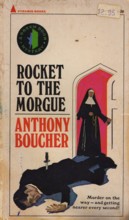
1967 edition |
They actually sound like they'd be a lot of fun to read, if not the kind of fiction that Don Stuart is advocating!
Boucher also comments on the one type of science fiction Campbell thought could never be written:
| "You see why we can't have detective stories in science fiction? It's the one impossible form for Don's hypothetical magazine of the twenty-fifth century. So many maneuverings are logically possible that you could never conceivably exclude the guilt of anyone. So you understand now how childishly simple your locked room is to a science fictioneer?" |
Isaac Asimov mentions this penchant of John W. Campbell's, as well, and points out that he wrote his novel, The Caves of Steel in 1953, to prove that a science fiction fair-play detective novel could be written.
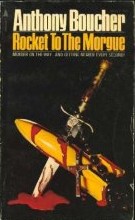
1988 edition |
The fans
In conducting his investigations, Detective Marshall visits a science fiction fan, Arthur Waring, whom he expects to be in his twenties or older, because of the sophisticated language and scientific knowledge displayed in a letter Waring had written to the victim Runcible.
| An infant with pink and downy cheeks answered Marshall's ring. "I'd like to speak to Arthur Waring," the Lieutenant announced.
"That's me," the lad replied in a clear soprano. |
|
Young Arthur Waring has a small room in his house, the walls covered with thousands of drawings...he intends to be a commercial illustrator when he finishes college. He belongs to the Califuturians, a science fiction fan club, and he publishes a fanzine called Fandemonium.
Boucher mentions conventions only in passing - in particular the the Denvention. The Denvention really did take place -- in 1941 -- it was the 3rd science fiction convention ever held, as a matter of fact. (which actually took place in 1941 in Denver, with Robert Heinlein as guest of honor. It would be the last Worldcon until after WWII.)
Some of the dramatis personae

Edmond Hamilton |

Robert Heinlein |
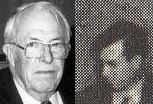
Jack Williamson (old and young) |

Jack Parsons |
Cleve Cartmill
|
(1908 - 1964)
Author of the famous "Deadline," a story about an atomic bomb which got the FBI nervous during WWII. |
Edmond Hamilton
|
(1904 - 1977)
Science fiction writer, author of among others the Captain Future novels. |
L. Ron Hubbard
| (1911 ? 1986)
The founder of Dianetics/Scientology. Author of Battlefield: Earth. Believer in the occult and former friend of rocket scientist Jack Parsons. |
Henry Kuttner
|
(1915 ? 1958)
Science fiction author married to C. L. Moore. Died at age 43 from a heart attack. |
Robert Heinlein
|
(1907 ? 1988)
Author of Space Cadet and Startship Troopers among many other novels and short stories
|
Jack Williamson
|
(1908 ? 2006)
Author of "With Folded Hands", among many other novels and short stories |
Jack Parsons
|
(1914 ? 1952)
Not an author (of science fiction), but a rocket scientist who also believed in the occult. In real life, a friend of L. Ron Hubbard's until Hubbard swindled him in a business deal. Died of injuries sustained in an explosion in his home laboratory. |
Jack Parsons
Jack Parsons was a "rocket scientist" who was one of the founders of the Jet Propulsion Laboratory (JPL). He was a friend of science fiction author L. Ron Hubbard (for a time), and like Hubbard, was a believer in the occult - and a devotee of Aleister Crowley.
In Rocket to the Morgue, Parsons appears in the character of Hugo Chantrelle, a scientist at Caltech who wishes to experiment with a rocket car...with unfortunately tragic results. (In the biography of Parsons called Strange Angel, author George Pendle states that the rocket car "appears at the book's end as the final and most gruesome murder weapon."
This is not the case. The rocket car is certainly used as a "gruesome" murder weapon, but halfway through the book, and it is not the cause of the final death.
Boucher does not really go into Parsons' occult beliefs, but gives it in a rather sanitized form:
| For Hugo hantrelle was an eccentric scientist. In working hours at the California Institute of of Technology he was an uninspired routine laboratory man; but on his own time he devoted himself to those peripheral aspects of science which the scientific purist damns as mumo-jumbo, those new alchemies and astrologies out of which the race may in time construct unsurmised wonders of chemistry and astronomy. |
Boucher's portrait of Parsons/Chantrelle seems an indulgently fond one, if anything:
| The rocketry of Pendray, the time-dreams of Dunne, the extra-sensory perceptions of the Rhine, the sea serpents of Gould, all these held his interests far more than any research conducted by the institute. He was inevitably a member of the Fortean Society of America, and had his own file of unbelievable incidents... It must be added in his favor that his scientific training automatically preserved him from the errors of the Master. His file was carefully authenticated, and oftem embellished with first-hand reports. |
See The Time Travelers' Guide for identifications of Pendray, Dunne, Rhine and Gould, among others.
During this "rocket party" as Boucher calls it, he cites the names of a few science fiction writers who attended. The names listed were pseudonyms for Robert Heinlein and J. Francis McComas (who will be Boucher's partner in The Magazine of Fantasy and Science Fiction 7 years later), respectively. (Again, see the Time Travelers Guide for complete details.
Anthony Boucher
According to Boucher, in his afterword written in 1951 and included in further reprints of this novel:
| "One of the first results of my conversion [to a science fiction enthusiast] (beyond immediately reading all the good pulp science fiction I could lay my hands on) was this novel, first published in 1942. In one way it was very badly timed: the readers of hardcover books had at that time never heard of science fiction, and the whole subject tended to seem a little unbelievable to them. In another way the timing was precisely right: I had an opportunity to present a first-hand picture of an important stage in the development of American popular entertainment- a phenomenon of which the book readers have become conscious only at second hand in the last couple of years.
I'm surprised on rereading Rocket to the Morgue [in 1967] to see how little its statements about science fiction have dated. Pulp rates for stories in the better markets are now about twice what is mentioned here (but then so is the cost of everything else-and some magazines are still paying 1940 rates). Science fiction is no longer restricted to the pulps; it now flourishes in slicks, in books, in films, radio, and television. There are more magazine markets for adult thoughts and prose; when this was written, there were only the two magazines edited by John W. Campbell, Jr. (known in Rocket as Don Stuart), but recently Life bracked as 'the aristocrats of science fiction": Campbell's Astounding, Horace Gold's Galaxy, and The Magazine of Fantasy and Science Fiction edited by me and J. Francis McComas.
|
Anthony Boucher is most famous in mystery rather than science fiction circles - the annual Bouchercon is a mystery convention, after all.
He was born William Anthony Parker White on August 21, 1911.
He was born in Oakland, California, and went to college at the University of Southern California. He received a Masters degree from the University of California, Berkeley.
Between 1942 and 1947 he reviewed mystery fiction for the San Francisco Chronicle.
Boucher was the first English translator of Jorge Luis Borges, translating "El jard?de senderos que se bifurcan" for Ellery Queen's Mystery Magazine.
He helped found the Mystery Writers of America in 1946 and, in the same year, was one of the first winners of the MWA's Edgar Award for his mystery reviews in the San Francisco Chronicle. He was founding editor (with J. Francis McComas) of The Magazine of Fantasy & Science Fiction from 1949 to 1958. He won the Hugo award for Best Professional Magazine in 1957 and 1958. Boucher also edited the long-running Best from Fantasy and Science Fiction anthology series, 1952-1959.
The 1940s were a busy decade for Boucher. From 1945 - 1948 he plotted more than 100 episodes of The Adventures of Ellery Queen,as well as plots for most of the Sherlock Holmes radio dramas.
By the summer of 1946 he had created his own mystery series for the airwaves, The Casebook of Gregory Hood. ("I was turning out three scripts each week for as many shows," he stated. "It was a mix of hard work and great fun.")
He left dramatic radio in 1948, "mainly because I was putting in a lot of hours working with J. Francis McComas in creating what soon became The Magazine of Fantasy and Science Fiction. We got it off the ground in 1949 and saw it take hold solidly by 1950. This was a major creative challenge and although I was involved in a lot of other projects, I stayed with F&SF into 1958."
During the last several years of his life Boucher:
Wrote a Sunday mystery column for the New York Times Book Review
Was chief critic for Ellery Queen's Mystery Magazine
Reviewed SF and fantasy (as H.H. Holmes) for the New York Herald Tribune
Edited True Crime Detective
Supervised the Mercury Mystery Line and later the Dell Great Mystery Library
Hosted Great Voices, his series of historical opera recordings for Pacifica Radio.
He died of lung cancer at the age of 57 on April 29, 1968.
Bibliography
Rocket to the Morgue, Anthony Boucher, 1942
Rocket to the Morgue has been discussed on the rec.arts.sf.written newsgroup.
Strange Angel: The Otherwordly Life of Rocket Scientist John Whiteside Parsons, George Pendle, 2005
Wikipedia entry on Anthony Boucher. Verified.
 |
Warning! Warning!
Warning!
Danger! You might miss intriguing updates if you do not subscribe to
The Thunder Child mailing list!
Warning!
Warning! Warning!
|
|
Support this site
|











